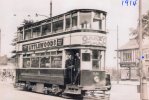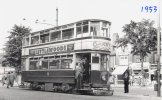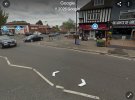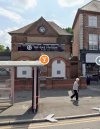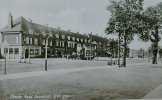-
Welcome to this forum . We are a worldwide group with a common interest in Birmingham and its history. While here, please follow a few simple rules. We ask that you respect other members, thank those who have helped you and please keep your contributions on-topic with the thread.
We do hope you enjoy your visit. BHF Admin Team
You are using an out of date browser. It may not display this or other websites correctly.
You should upgrade or use an alternative browser.
You should upgrade or use an alternative browser.
Bundy clocks around Birmingham
- Thread starter Radiorails
- Start date
There's possibly something odd about the first photo. It has the exact same adverts as the photo nearly 40 years later. Any thoughts? Or maybe I got the date wrong ? I suspect the first one is also from the 1950s and is incorrectly listed as 1914.
Last edited:
see what you mean viv....both photos definately taken in the same location...i agree with you that photo one was not taken in 1914 especially looking at how the 2 men standing on the tram are dressedThere's possibly something odd about the first photo. It has the exact same adverts as the photo nearly 40 years later. Any thoughts? Or maybe I got the date wrong ? I suspect the first one is also from the 1950s and is incorrectly listed as 1914.
lyn
Radiorails
master brummie
Indeed, Vivienne, 1914 is incorrect. It was taken post WW2 for certain at a guess around 1950. The photo dated 1953 I am sure is correct as the 2 tram route to Erdington, the last of their kind in the city, ceased operation in July 1953, hence. I believe, removal of the Bundy Clock and the positioning of a temporary tram stop sign is evidence for this. This tram was broken up and sent to scrap in August 1953.
Most BCT trams had long lives, 1919 - 1953, and underwent many modifications in that time, such as electrical components, gearing, trucks (proper name for the wheel housing), seating and in their early life gained roofs.
Most BCT trams had long lives, 1919 - 1953, and underwent many modifications in that time, such as electrical components, gearing, trucks (proper name for the wheel housing), seating and in their early life gained roofs.
Last edited:
Lloyd
master brummie
Most of the Washwood Heath depot trams had bow collectors, and were used on the Washwood Heath 10 route as well. The overhead line equipment was slightly different to allow for these cars to collect current, and a small number remained fitted with poles to enable special workings, e.g Dunlop & Austin works services that ran across the city, and bank holiday extras on the 70 to Rednal for the Lickeys, when spare cars from any depot were required for the 3-4 minute headway. The 'different' overhead could be used by normal trolley pole cars, but not vice versa, and approaching the closure of the depot's routes those that were going to be kept and transferred for further service at the remaining depots were converted to standard poles.The most notable thing about route 8, Alum Rock, was the use of a bow collector other than than the usual BCT tradition of trolley pole. The only other route to have bow collectors was route 32 Lodge Road. This was due to the sharp turns on the 32 whereas the 8 was due to two bridges.
The use of bow collectors had nothing to do with corners or bridges, (in fact at a couple of bridges the trolley wire ran to the side as it was lower than the car's roof) but was an ongoing experiment as the slightly different overhead line did not need to have frogs (points) which would make for cheaper overhead construction. However, unless the whole fleet had been equipped with the collectors, frogs would still be necessary so the idea was not advanced beyond the routes and cars already converted.
Radiorails
master brummie
I have edited my post 88 for clarification.. i still believe the 32 route to be circuitous and also Birmingham's most hilly one. They were the oldest in the fleet and were shorter in length that others in the fleet. It was not a smooth ride, I regularly visited an uncle on the 32 and to me they were reminiscent of a fairground.  The nickname given by locals, was apparently, "The Dipper".
The nickname given by locals, was apparently, "The Dipper".
Lloyd
master brummie
I think the steepest hill on the tramway system was at Hill Top, between West Bromwich & Wednesbury. I was told that in icy or snowy weather, the first car to Wednesbury would go down the hill "wrong road" (i.e. on the right hand side) to ensure the rails were clear to enable the car to get back up on the return journey.I have edited my post 88 for clarification.. i still believe the 32 route to be circuitous and also Birmingham's most hilly one. They were the oldest in the fleet and were shorter in length that others in the fleet. It was not a smooth ride, I regularly visited an uncle on the 32 and to me they were reminiscent of a fairground.The nickname given by locals, was apparently, "The Dipper".
Yes the Lodge Road route used short 3-window cars on two axles, which would allow them to 'hunt' (swing from side to side) at anything ablove walking speed.
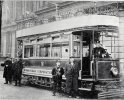
Radiorails
master brummie
When I visited my uncle who lived along the 32 tram route, with my father, I always had a book read whilst I was there. A favourite one was an account which suggested that playing with matches was dangerous and any child with any sense would not do it. 
I did not realise that this must have a had a significant effect on my memory as it was until a few year later, after Air Force service that I joined the Fire Brigade.
I did not realise that this must have a had a significant effect on my memory as it was until a few year later, after Air Force service that I joined the Fire Brigade.

